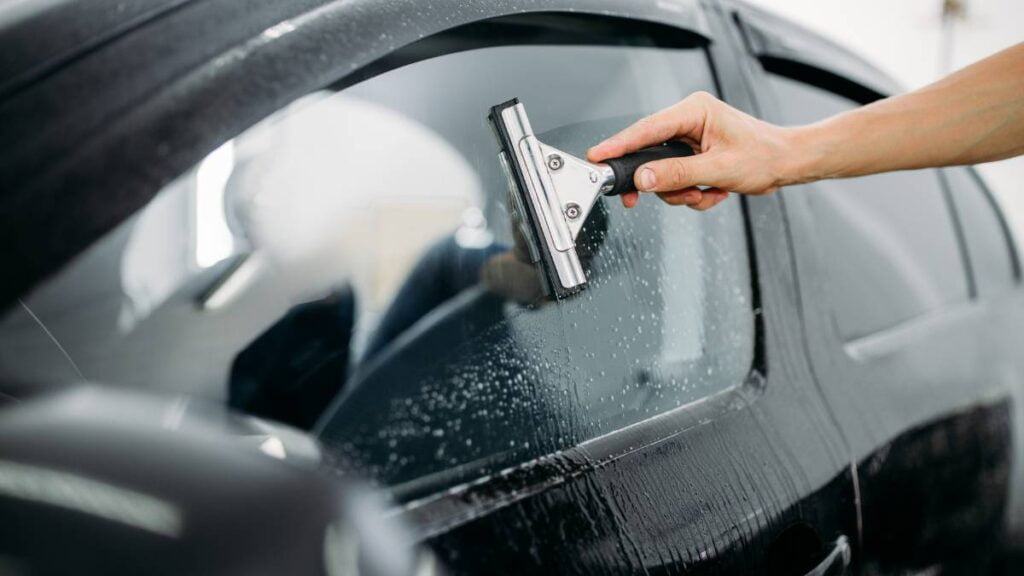There’s nothing quite as uncomfortable as stepping into a scorching hot car after it’s been baking in the sun. This not only poses a problem of discomfort but can also be harmful to your car’s interior, as prolonged exposure to sunlight can cause materials to fade or crack. Enter window tinting, a practical solution to these problems. But how exactly does window tinting work to reduce heat inside a car?
In this article, from the expert detailing team at Pave Automotive Professional Car Care in Leigh near Wigan, we’ll explore more about the heat-reducing properties of window tint and find out which type of window tint is most effective at bringing down the temperature inside your vehicle.
What is window tint?
Window tint is a thin laminated film applied to the glass surfaces of vehicles, buildings, and sometimes electronic devices. Its primary purpose in vehicles is to reduce the amount of ultraviolet (UV) radiation, visible light, and infrared radiation (heat) entering through the windows.
Made from layers of different materials, including polyester for strength and flexibility, window tints often contain a tinting agent, which determines the darkness of the shade. While primarily known for its heat-reducing properties, window tint also offers privacy, enhances the aesthetic appeal of vehicles, and provides an additional layer of safety, preventing the glass from shattering upon impact.

Moreover, by blocking up to 99% of UV rays, it protects vehicle occupants from harmful radiation and prolongs the lifespan of the car’s interior by reducing the chances of fading and wear. In a nutshell, window tinting is both functional and decorative, enhancing comfort and safety while giving the vehicle a sleek appearance.
What are the main properties of window tint?
Window tint is a multifunctional tool that enhances both the aesthetics and efficiency of windows. To understand its effectiveness and versatility, let’s delve into the main properties of window tint:
Visible Light Transmission (VLT)
This measures the percentage of visible light allowed through the tint. A lower VLT value means the tint is darker and lets in less light, whereas a higher VLT means the tint is lighter.
Ultraviolet (UV) Radiation Blocking
High-quality tints block up to 99% of harmful UV rays. This not only protects the vehicle’s occupants from potential skin damage but also prevents the car’s interior from fading and cracking.
Infrared (IR) Rejection
Infrared radiation is responsible for the heat you feel from sunlight. The IR rejection property indicates how much of this heat-producing radiation is blocked. Higher IR rejection rates translate to cooler interiors.
Colour and Aesthetics
Window tints are available in a variety of shades and colours, from nearly transparent to opaque, catering to different aesthetic preferences.
Shatter Resistance
Some tints are designed to hold window glass together upon impact, increasing safety.
How does window tint reduce the temperature inside a car?
Window tint can significantly help maintain a more comfortable interior temperature in cars, especially during the searing heat of summer days. Here’s how it achieves this:
Reflecting Solar Radiation
The primary function of window tinting films is to act as a barrier against the sun’s overwhelming energy. Many of these films are embedded with metals or special compounds designed to reflect solar radiation. By doing so, they essentially act as a mirror, sending a significant portion of the sun’s rays back into the atmosphere and away from the car’s interior. This reflective capability is often what gives tinted windows their characteristic shimmer when viewed from outside.
Absorbing Infrared Radiation
Infrared radiation is the segment of sunlight that imparts the sensation of heat. High-quality tint films have the ability to absorb a substantial amount of this incoming infrared radiation. By capturing and not allowing these rays to penetrate through the windows, the tint ensures that the car’s interior remains relatively cooler.
Blocking UV Rays
Ultraviolet rays, although not a heat source, can elevate the temperature inside a car by causing damage to its interiors. Materials like leather or fabric can heat up and release stored heat when exposed to UV radiation. By blocking nearly 99% of UV rays, window tints prevent this indirect heating mechanism. Moreover, these rays are harmful to human skin and prolonged exposure can lead to skin ailments, including cancer. Thus, the tint not only provides a cooler environment but also a healthier one.
In essence, a combination of reflection, absorption, and blocking allows window tints to significantly reduce the temperature inside a car, making the journey more comfortable and safeguarding both the passengers and the car’s interior from the sun’s detrimental effects.

Which is the most effective type of window tint to reduce heat?
There are various types of window tints available, such as dyed, metallic, carbon, and ceramic. Ceramic window tints tend to be the most effective in reducing heat. They use nano-ceramic technology to block out both UV and infrared rays effectively, thereby greatly reducing the heat inside the car.
Premium window tint services in Leigh near Wigan, North West England.
For car owners in the North West of England, who are in search of top-notch window tinting services in Leigh near Wigan, look no further than Pave Automotive Professional Car Care.
For more info on our window tint services, head on down to our service centre. We are located at Unit 28 Meadowcroft Way in Leigh Business Park, WN7 3XZ. Please call us at 01942 936375 if you want to arrange an appointment or have any queries.








